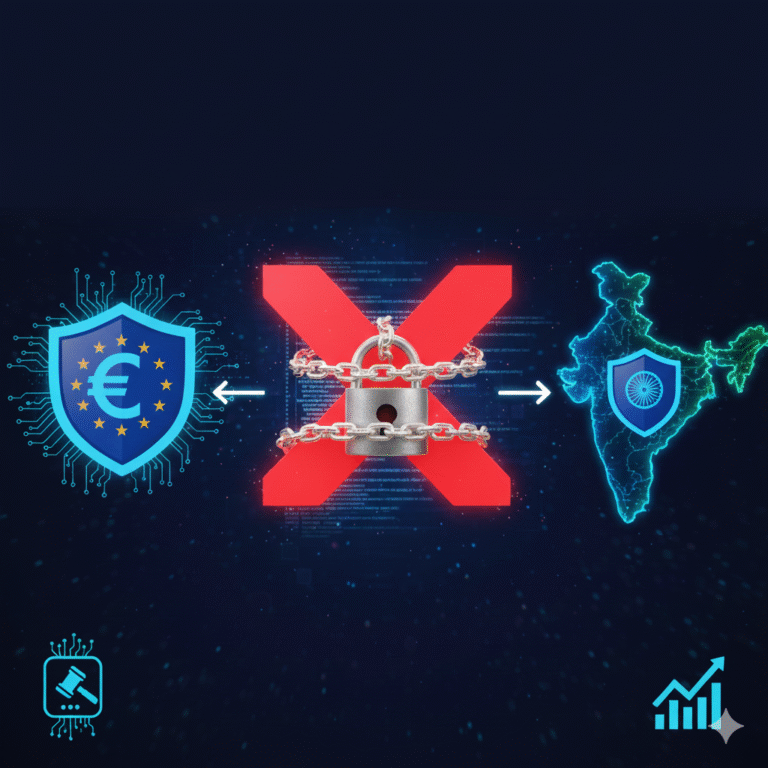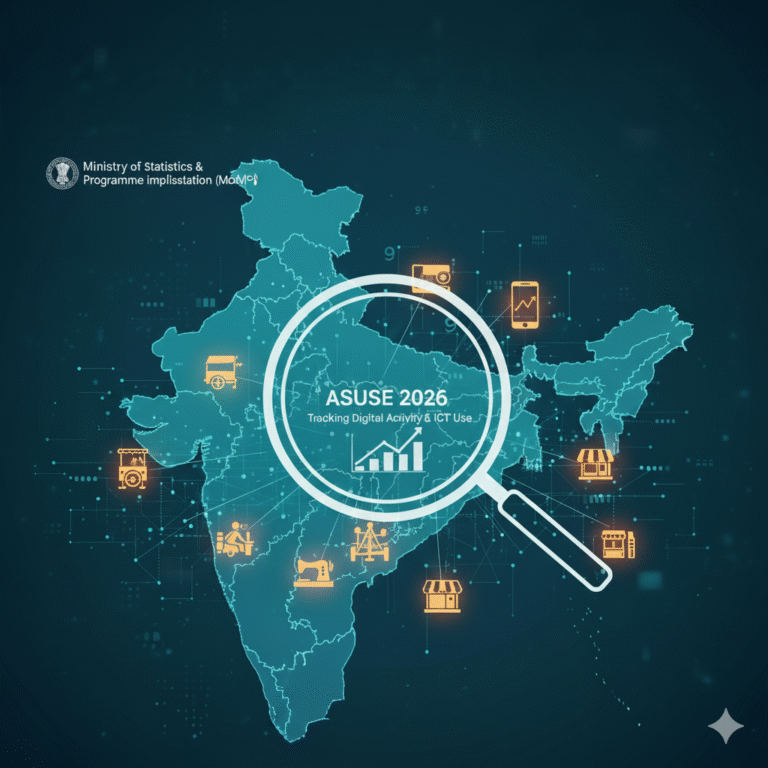Key Highlights:
- While IIT-ICCT study confirms BEVs emit 38% less lifecycle emissions than ICE vehicles, the critical caveat remains unaddressed: 77.7% of India’s current EV charging comes from fossil fuels (primarily coal), undermining emissions reductions by up to 368 g CO2e/km—equivalent to adding 2-3 petrol cars per kilometer driven.
- India generates 3.2 million tonnes of e-waste annually with lithium-ion battery waste growing at 30% CAGR, yet less than 5% reaches authorized recyclers—first mass retirement of 2 million EVs expected around 2030 will exponentially amplify crisis unless recycling infrastructure scales immediately.
- India faces 100% import dependency for lithium and cobalt (82% from China), exposing EV supply chains to geopolitical vulnerability as critical minerals demand doubles by 2030 while domestic mining remains 10+ years away from operationalization.
- FAME II’s ₹11,500 crore investment achieved 3.89 million EVs incentivized through 2025 but lacks integration with renewable energy targets, grid decarbonization timelines, or recycling infrastructure—creating appearance of progress masking incomplete ecosystem development.
- Policy coordination gaps between MeitY (manufacturing), MoPNG (energy), and MNRE (renewables) allow contradictory trajectories: EV rollout accelerates while coal-dependent grid strengthens, and battery recycling remains orphaned between regulators despite Extended Producer Responsibility framework existence.

India’s electric vehicle revolution appears triumphant: 1.89 million EVs registered in 2025, 11x growth from 2020, government subsidies flowing, manufacturers scaling. Ministers tout clean mobility. Environmentalists celebrate emissions reductions. Media headlines herald India’s green transformation.
But beneath the surface lies an uncomfortable truth: India is building a clean-looking EV ecosystem powered by coal, dependent on foreign minerals, and unprepared for battery recycling crisis arriving by 2030. The IIT-ICCT lifecycle analysis showing 38% emissions reduction sounds impressive—until recognizing that 77.7% of charging electricity comes from fossil fuels, meaning theoretical gains remain unrealized on ground. downtoearth
This isn’t merely technical challenge. It’s policy failure stemming from disconnected decision-making across multiple government silos, absence of integrated planning, and prioritization of EV adoption metrics over genuine sustainability. Understanding India’s hidden EV footprint requires examining the uncomfortable gap between ambition and execution—critical for India’s strategic autonomy goals.
The Promise vs. The Hidden Footprint: Lifecycle Emissions Reality Check
The Headline Study and Its Nuances
In June 2025, IIT Roorkee and International Council on Clean Transportation (ICCT) released landmark research becoming government talking point: BEVs reduce lifecycle emissions 38% compared to ICE vehicles in India. newindianexpress.com
This study represents sophisticated lifecycle assessment examining complete vehicle journey from raw material extraction through manufacturing, operation, to recycling. For passenger cars, BEVs demonstrated 242 g CO2-equivalent per kilometer compared to 395 g for ICE vehicles—validating environmental advantage.
But the study simultaneously revealed critical caveats buried in methodology sections:
Grid Carbon Intensity Dominance: Three factors explain 75% of lifecycle emissions variation—grid carbon intensity (coal vs. renewables), lab-test energy consumption assumptions, and real-world driving adjustments. Grid composition represents single largest variable. Current 77.7% coal-based grid fundamentally constrains emissions benefits.
Manufacturing Stage Coal Dependency: The 38% advantage assumes current manufacturing patterns, heavily reliant on coal-powered cement production, steel manufacturing, and component fabrication. Most EV and battery manufacturers globally lack renewable energy integration in production.
The Hidden Emissions Calculus: While tailpipe emissions become zero with EVs, the research demonstrates charging from coal-fired electricity generates equivalent emissions to moderate ICEV operation. If coal comprises 80% of grid (current trajectory), BEV emissions advantage shrinks to meaningful-but-not-transformative levels.
Grid Carbon Intensity: The Constraint Nobody Discusses
Current Indian electricity grid emits approximately 725 grams CO2 per kilowatt-hour. This compares to global average of 415 g CO2/kWh. energetica-india
For perspective: a typical electric car charging during hours when coal-fired plants operate at full capacity accumulates emissions equivalent to moderate hybrid vehicle operation. The research authors explicitly warned against delaying EV adoption, acknowledging coal-dependent charging remains superior to perpetual ICE vehicle purchase—but this optimistic framing masks the reality that genuine emissions reduction remains 10+ years away until renewable energy grid transformation.
The E-Waste Crisis: The Billion-Ton Tsunami Arriving by 2030

Current E-Waste Generation and Processing Gaps
India generates 3.2 million tonnes of e-waste annually—with lithium-ion battery waste growing at staggering 30% compound annual growth rate (CAGR).
Of this e-waste, less than 5% reaches authorized recyclers. This means 95% enters informal recycling channels—unregulated networks causing environmental devastation: uncontrolled acid leaching, heavy metal contamination, air pollution, worker health destruction.
The Authorized Recycling Capacity Gap
As of 2025, India possesses limited authorized lithium-ion battery recycling capacity. Recyclekaro, India’s leading facility, expanded to 24,000 MT annual capacity (from 7,500 MT previously). A few other authorized operators exist but collectively handle fraction of annual e-waste generation.
Meanwhile, informal recycling—employing 95% of current e-waste volume—operates through murky supply chains extracting value without environmental safeguards.
The 2030 Crisis Deadline
Electric vehicles purchased in 2015-2019 (first major adoption wave) will reach end-of-life around 2028-2032. Battery degradation reaches threshold warranting replacement—triggering mass retirement of 2+ million EVs simultaneously. recyclinginternational
This creates staggering challenge: processing 2 million EV batteries in 3-5 year window requires 20-30x current authorized recycling capacity. Failing to build infrastructure now means 2030 crisis becomes inevitable, forcing India to export batteries for recycling (or landfill) at enormous cost.
The Opportunity Within Crisis: Battery Recycling Economics
Critical minerals recovered from recycled batteries (lithium, cobalt, nickel, manganese) command significant value—Recyclekaro recovers these at 95% efficiency and 99.5% purity. Recycled critical minerals cost 40-50% less than virgin mining.
India faces choice: invest ₹5,000-10,000 crore building authorized recycling infrastructure by 2028, or face 2030 crisis requiring ₹20,000+ crore emergency response. The economic logic supports proactive investment, yet policy implementation remains inadequate. certification-india
Critical Mineral Dependency: Geopolitical Vulnerability Masquerading as Development
The Import Dependency Reality
India imports 100% of lithium and cobalt—82% of lithium sourced from China.
This dependency transcends mere economics. It represents strategic vulnerability. During India-China tensions, supply disruption becomes policy tool. During global supply chain disruptions, Indian EV manufacturing halts.
The Scale of Dependency Challenge
Current EV market requires approximately 50,000-60,000 tonnes annual lithium-oxide consumption (within next 5 years, rising to 200,000+ tonnes by 2030).
Globally, only Australia (40% production), Chile (25%), and China (15%) supply majority lithium. India’s access depends entirely on geopolitically-influenced trade relationships.
Meanwhile, domestic lithium deposits in Jammu-Kashmir and Rajasthan remain at preliminary exploration stage—10-15 years minimum before operational production. ieefa
Nickel and Cobalt Complications
Beyond lithium, nickel and cobalt dependency poses additional concerns. Nickel sourcing depends on Indonesia (major supplier), creating alternative geopolitical pressure point. Cobalt sourcing similarly concentrated in Democratic Republic of Congo and processing largely controlled by China.
India’s approach—increasing mineral imports from “friendly nations” like Australia, Chile, South Africa—provides modest diversification but doesn’t eliminate fundamental dependency on mineral-exporting nations.
Supply Chain Security Strategy Gaps
India’s National Critical Mineral Mission (announced) sets aspirational goals but lacks implementation timeline, financing mechanisms, or enforcement authority. Government exploration initiatives through Geological Survey of India progress slowly—decades-long timelines exceed EV adoption acceleration pace.
Strategic partnerships through Minerals Security Partnership provide some assurance but don’t eliminate 10+ year gap between EV scaling and domestic mining capability.
Policy Framework Gaps: Where Ambition Meets Implementation Reality

FAME II: Subsidy Success, Integration Failure
- FAME II allocated ₹11,500 crore (₹100 billion base + spillover) since 2019, incentivizing 3.89 million EVs through March 2025.
- From subsidy deployment perspective, the scheme succeeded: rapid EV adoption, market transformation, manufacturing sector expansion.
But the scheme failed in critical integration dimensions:
Renewable Energy Mandates Absent: FAME II includes zero requirement that subsidized EV charging infrastructure connect to renewable energy sources. Consequently, charging stations proliferate without grid decarbonization planning.
Grid Alignment Failures: EV rollout proceeded independently from electricity capacity planning, renewable energy expansion timelines, or grid modernization strategies. The result: accelerating EV adoption met with coal-dependent generation infrastructure.
Manufacturing Energy Standards Missing: FAME II includes no requirements that EV/battery manufacturers achieve renewable energy targets in production. Consequently, manufacturing stage emissions remain coal-intensive despite policy pushing electrification.
Battery Waste Management Rules: Policy Without Capacity
The Battery Waste Management Rules (2022) established Extended Producer Responsibility (EPR) framework—mandating manufacturers ensure end-of-life battery recycling.
The regulatory framework appears comprehensive on paper: collection targets, recycling obligations, material recovery requirements, EPR certificate mechanisms.
Implementation reality proved far less impressive:
Authorized Recycler Shortage: EPR obligations require 80%+ collection and 95%+ material recovery, but authorized capacity handles mere 5% of current e-waste. Manufacturers meet obligations through informal channels lacking environmental safeguards.
Reverse Logistics Vacuum: EPR mandates collection but doesn’t specify reverse logistics mechanisms—how batteries travel from end-users through authorized channels to recyclers. Consequently, informal networks capture waste.
Capacity Building Delays: Creating authorized recycling infrastructure requires investment in facilities, trained workforce, and certification processes—elements entirely absent from EPR framework.
National Critical Mineral Mission: Aspiration Without Timeline
India announced National Critical Mineral Mission establishing grand objectives around domestic production. Yet concrete implementation remains lacking:
- Domestic lithium mining exploration has progressed slowly with no clear production timelines.
- Mining projects face environmental opposition, requiring resolution before advancing.
- Processing infrastructure for refined minerals remains dependent on imports.
The mission reflects strategic awareness of vulnerability but demonstrates implementation gap between policy announcement and execution capability.
Renewable Energy Integration: Parallel Systems Rather Than Integration
India’s renewable energy expansion (national target of 486 GW wind and solar by 2032) proceeds independently from EV infrastructure planning. The result: renewable capacity comes online but doesn’t preferentially serve EV charging.
Green Energy Open Access Rules (2022) theoretically enable consumers to directly purchase renewable electricity. But implementation remains minimal—only high-consumption users (100 kW+) participate, excluding residential EV chargers.
Industry Best Practices: Exceptions Proving the Rule
Attero: The Circular Economy Pioneer
Attero operates with 100% renewable-powered recycling facility, recovering lithium, cobalt, nickel with exceptional efficiency. Their model demonstrates that sustainable recycling isn’t merely theoretical—proven at commercial scale.
Yet Attero represents exception rather than industry norm. Most manufacturers remain fossil-fuel dependent in both manufacturing and recycling operations.
Omega Seiki Mobility: Partial Clean Integration
Omega Seiki Mobility achieved 60% renewable energy in EV manufacturing, targeting 100% by 2030. Additionally, the company explores local battery cell manufacturing joint ventures rather than perpetual imports.
These initiatives demonstrate feasible pathways for manufacturers seeking genuine sustainability. Yet Omega Seiki remains outlier.
The Gap: Why Industry Lags Policy Intention
Industry capacity for clean manufacturing exceeds regulatory requirements—Attero and Omega demonstrate feasibility. Yet absent mandatory standards, manufacturers optimize for cost rather than sustainability.
FAME II subsidies don’t require renewable energy integration in manufacturing—consequently, rational profit-maximizing manufacturers maintain fossil fuel dependence.
This represents market failure requiring policy intervention.
Strategic Implications for India: Atmanirbhar Bharat’s Incomplete Vision
Localization Aspirations vs. Energy Sovereignty Reality
India’s Atmanirbhar Bharat vision for EVs targets indigenous cell manufacturing by 2026. This ambition aims reducing import dependency and creating manufacturing employment.
But the vision remains incomplete without parallel energy sovereignty achievement:
- Indigenous cell manufacturing powered entirely by coal doesn’t represent Atmanirbhar—merely substituting equipment import dependency with energy import vulnerability.
- Genuinely self-reliant EV ecosystem requires indigenous manufacturing powered by domestic renewable energy, using recycled critical minerals, and supported by homegrown battery recycling infrastructure.
Current trajectory achieves first objective (manufacturing) while neglecting the other three—representing incomplete Atmanirbhar.
Energy Security Paradox: Fossil Fuel Lock-In
- Coal power plants built today to support EV charging face 40+ year operational lifespans. These investments create institutional and financial lock-in—utilities and policymakers resist transition away from coal infrastructure despite EV proliferation.
- India risks paradoxical outcome: rapid EV adoption driving massive coal plant construction to satisfy charging demand, extending fossil fuel infrastructure lock-in by decades.
This contradicts genuine energy security—which demands diversifying away from imported fossil fuels.
Resource Security: Geopolitical Vulnerability
- China’s dominance in EV and battery supply chains (not merely raw minerals but also refining, cell manufacturing, and components) creates asymmetric dependency.
- During strategic competition with China over South China Sea, Taiwan, or other geopolitical flashpoints, critical mineral supply becomes leverage point.
- India’s EV expansion without addressing supply chain vulnerability means embedding Chinese dependence precisely when strategic autonomy becomes premium geopolitical priority.
Recommendations: Building Genuinely Green Mobility Ecosystem
Clean Manufacturing Mandate: From Aspiration to Enforcement
Government should establish binding renewable energy targets for EV and battery manufacturers:
- 2027 Target: 50% renewable energy in manufacturing.
- 2030 Target: 100% renewable energy in manufacturing.
Manufacturers missing targets face penalty: subsidy withdrawal, procurement exclusion from government vehicles, or equivalent financial consequences.
This single policy measure would accelerate renewable energy adoption across manufacturing sector while ensuring FAME II subsidies genuinely support clean mobility.
Critical Mineral Strategy: Proactive Mining and Recycling
India requires dual-track critical mineral strategy:
Domestic Production Acceleration:
- Fast-track lithium mining in Jammu-Kashmir and Rajasthan with environmental safeguards.
- Invest ₹5,000 crore in mining infrastructure acceleration.
- Establish domestic mineral processing capability rather than dependence on imported refined materials.
Recycling Capacity Building:
- Allocate ₹10,000 crore creating authorized battery recycling capacity scaling to 100,000+ MT annually by 2030.
- Establish dedicated recycling zones with environmental containment, preventing informal channel migration.
- Create tax incentives and subsidies for recyclers achieving environmental standards.
Grid Decarbonization Alignment: Integrated Planning
Rather than parallel EV and renewable energy expansions, India must integrate planning:
- Identify 2,000+ high-capacity EV charging locations requiring dedicated renewable energy capacity.
- Require solar and wind generators prioritize EV charging stations for power delivery.
- Establish Green Energy Open Access pathways enabling residential and commercial EV chargers accessing renewable electricity.
- Target: 100% renewable energy for EV charging by 2032 (aligned with renewable energy expansion timeline).
Policy Coordination Mechanism: Institutional Reform
Create inter-ministerial task force coordinating MeitY, MoPNG, MNRE, and state energy departments:
- Monthly coordination meetings aligning EV adoption with renewable energy and recycling infrastructure.
- Shared performance metrics linking FAME II disbursements to grid decarbonization and recycling capacity targets.
- Unified data platform tracking EV adoption, grid emissions, and recycling volumes enabling real-time course correction.
Extended Producer Responsibility Enforcement Strengthening
Transform EPR from regulatory paper to operational reality:
- Establish EPR fund where manufacturers pay into pool financing authorized recycling infrastructure.
- Create reverse logistics network mapping battery collection, transportation, and recycling.
- Implement quarterly audits verifying manufacturers meet collection and recycling targets.
- Penalize manufacturers falling short through progressive fines and subsidy withdrawal.
Consumer Awareness and Battery Disposal Campaigns
Create mass awareness enabling consumers to properly dispose end-of-life batteries:
- Launch ₹100 crore awareness campaign through social media, mobile networks, and community organizations.
- Establish 5,000+ battery collection points in cities enabling convenient disposal.
- Provide modest incentives (₹500-1,000) for proper battery disposal encouraging compliance.
Way Forward: Integrated Policy Approach
Genuine green mobility requires holistic transformation across five domains simultaneously:
- Clean Manufacturing: Renewable energy integration in EV and battery production
- Grid Decarbonization: Renewable energy alignment with EV charging infrastructure
- Critical Mineral Sovereignty: Domestic production and recycling infrastructure
- Battery Recycling Ecosystem: Authorized capacity scaling and reverse logistics
- Governance Integration: Coordinated implementation across government silos
Absent comprehensive approach addressing all five, India constructs cosmetic green infrastructure while perpetuating fossil fuel dependency and geopolitical vulnerability.
Conclusion: From Green Illusion to Genuine Sustainability
India’s EV revolution represents genuine progress toward sustainable mobility—the IIT-ICCT study validating 38% emissions reductions remains legitimate achievement.
Yet celebrating current progress blinds policymakers to mounting challenges:
Coal-dependent grids will supply 77% of EV charging for next decade, undermining headline emissions benefits. E-waste crisis arrives by 2030 unless recycling infrastructure scales dramatically. Critical mineral dependency exposes supply chains to geopolitical leverage. Policy fragmentation creates parallel initiatives proceeding independently rather than integrated transformation.
The choice before India’s policymakers: acknowledge hidden footprint and implement comprehensive reforms addressing manufacturing, grid, minerals, and recycling simultaneously—or continue cosmetic progress while building green-looking infrastructure powered by coal and dependent on geopolitical adversaries.
Atmanirbhar Bharat demands the former: genuine autonomy, not merely manufactured automobiles.









+ There are no comments
Add yours